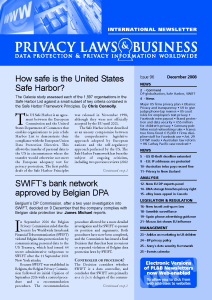 About Us - Galexia News
About Us - Galexia News
New Galexia Study: The US Safe Harbor - Fact or Fiction? - December 2008
| |||||||||
The US Safe Harbor is an agreement between the European Commission and the United States Department of Commerce that enables organisations to join a Safe Harbor List to demonstrate their compliance with the European Union Data Protection Directive, allowing the transfer of personal data to the US in circumstances where the transfer would otherwise not meet the European adequacy test for privacy protection.
First released in November 1998, and officially accepted by the EU in 2000, the Safe Harbor is best described as an uneasy compromise between the comprehensive legislative approach adopted by European nations and the self-regulatory approach preferred by the US. The Safe Harbor Framework has been the subject of ongoing criticism, including two previous reviews (2002 and 2004). Those reviews expressed serious concerns about the effectiveness of the Safe Harbor as a privacy protection mechanism.
After ten years of public debate it is time to examine the Safe Harbor again. Chris Connolly’s article The US Safe Harbor - Fact or Fiction? summarises the findings of a Galexia study regarding the current status of the Safe Harbor Framework. The Galexia study assessed each of the organisations listed on the Safe Harbor List (1,597 entries) against a small subset of key criteria contained in the Safe Harbor Framework Principles.
This article was published in Privacy Laws and Business International, issue 96, December 2008.
Browse online:
- Title page
- Contents
- 1. Introduction
- 2. Previous reviews of the Safe Harbor Framework
- 3. Safe Harbor participants
- 4. Compliant members
- 5. Detailed Findings
- 6. Recommendations
- 7. Appendix - Methodology for this study
![[ Galexia Dots ]](/images/hr.gif)

![[Data protection regulations and international data flows: Implications for trade and development (April 2016)]](/public/ssi/pubs/pub_6.png)



 print this page
print this page sitemap
sitemap manage email subscriptions
manage email subscriptions